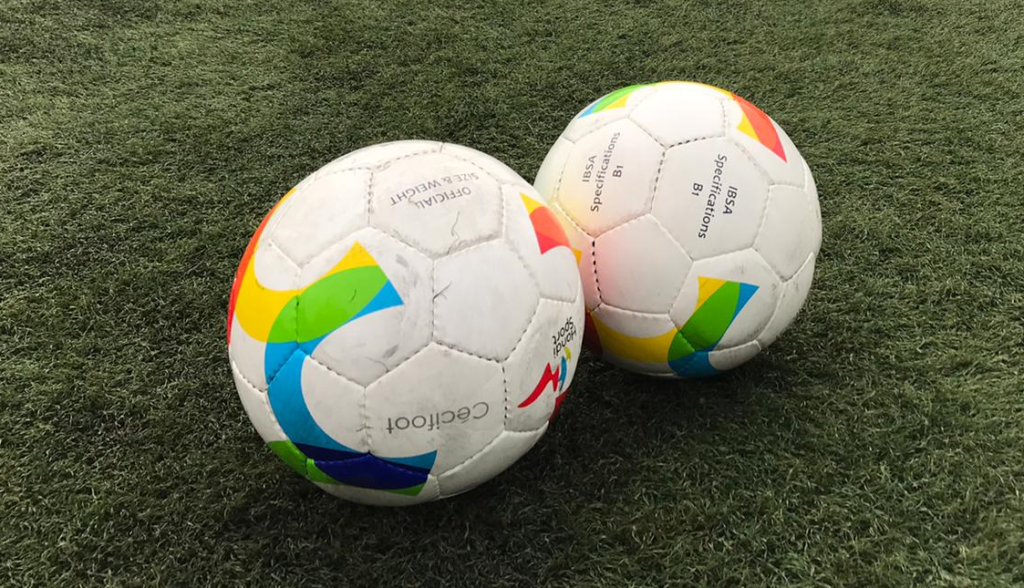|
Getting your Trinity Audio player ready...
|
A blind football player has the classic equipment common to anyone who wants to play football :
- a uniform with one jersey and one short : the jersey must have a number from 1 to 15, different for each player. The color must be different between two competing teams to distinguish them.
Note that the goalkeeper must wear a jersey whose color differentiates him from the other players of his team and the referees. - high socks
- shin guards : they must be covered by the socks and offer an adequate degree of protection
- shoes adapted to the type of field (usually synthetic). They must not have spikes to avoid any risk of injury in case of contact with an opponent.

YES NO
As mentioned above, blind football is a contact sport so players should not wear any jewelry or watches on any part of their body. Nothing that could injure another participant or the player himself during a match.
After this classic soccer equipment, there are some particularities specific to blind football. There are some pieces of equipment that are common to both categories of this sport and others that are more specific.
Equipment common to both categories (B1 and B2/B3)

This special ball has specific characteristics :
- it is spherical
- has a sound system inside allowing it to be located by the players when it is in motion
- must have a circumference between 60 and 62 cm
- must be inflated with a pressure between 400 and 600 g/cm2 (i.e. 0.4-0.6 atm)
Difference for B2/B3 matches in the French championship : the principle of the bells inside the ball is the same as in B1 but the sound system is lighter. On the other hand, the B2/B3 category uses “futsal” type balls with the only difference being that the color of the ball is clearly different from the ground. The players will thus perceive the ball better visually. France has chosen to use balls with bells for its national championship B2/B3 in order to allow access to severely visually impaired players.

These are the rules imposed by the IBSA (International Blind Sports Federation) for a ball to be approved and therefore suitable for use in competition.
During a match, it is the role of the referee to :
- ensure that the balloon is working properly. He may have to replace it in case of anomaly. No change of ball is allowed without his agreement. However, the players may report to the referee if they cannot hear the ball sufficiently.
- signal the position of the ball by rolling it under his foot so that it makes a sound if it is stationary and no player can locate it.
- stop the game if the ball bursts or is damaged.
Below is a sound video (⚠️ so please turn on the sound ⚠️) allowing you to hear the noise the ball makes as it moves. In the video, a person stands, shakes the ball and then drops it to the ground and pretends to pass it to a teammate.
Specific equipment for B1 players
In category B1, the players are blind or visually impaired while the goalkeeper is sighted. In order to make all the field players equal in terms of vision, they will have to put a eyeshade on their eyes.

Photo Credit : Benjamin Guibal
In national and international competitions, the headband will be lined with eye patches. They will be glued to the skin at the level of each eye ; the eyeshade will be placed over them.
These two pieces of equipment must meet the following characteristics :
- the eyeshade : it must be placed over the eyes and be made of an opaque, absorbent material and padded on the front. Players must not be able to see through it.

- eye patches : to be sure that the players are visually equal, even with the masks, we apply occulting patches on their closed eyes

At the beginning of each game, the referee checks that the patches and masks are in place before starting the game. The same applies to substitutions, time-outs and the beginning of play after half-time. It is forbidden to remove your mask during a game.
Specific equipment for B2/B3 players
In category B2/B3, the players are visually impaired. As a reminder, there are two sub-categories :
- a player classified as B2 has a maximum visual acuity of 1/20 and a maximum visual field of 5°
- a B3 player has a visual acuity between 1/20 and 1/10 and a visual field between 5° and 20°
The specific equipment for players in this category is the B2/B3 headband : new for the 2020/2021 season in the French championship only.

It will be worn on the forehead of each player with the following characteristics :
- it will have a different color for each team, in addition to the distinctive jerseys. It will therefore help a player to visually identify his competitors and teammates on the field
- it will allow to differentiate the participants of different subcategories
- for a spectator coming to attend a game, it will help him to identify the differences of classification between the players and thus better understand the functioning of the discipline
Vous aimez cet article ? Aidez-nous à le faire connaître en le partageant :

